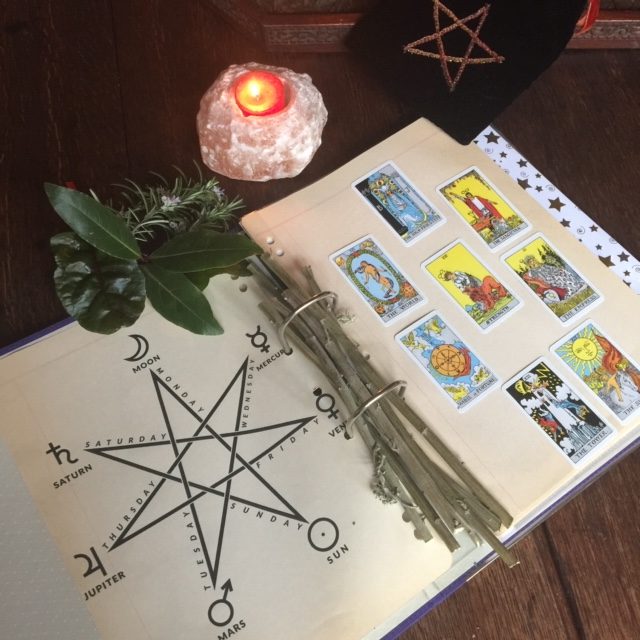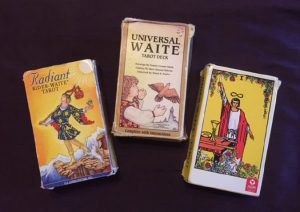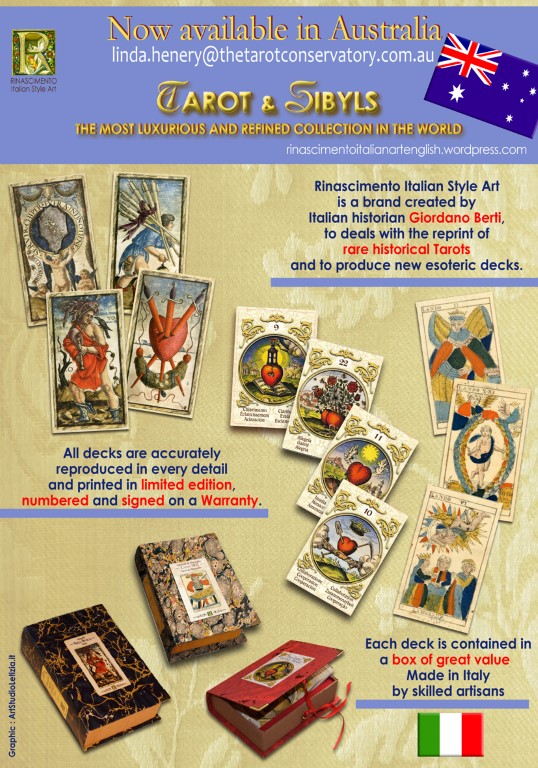Reading Tarot cards
You would like to read Tarot but not sure how to get started. We have all come from that point. There are so many decks of cards, books and information on line as to meaning of the cards, it can be so confusing! Reading tarot is something you do, not just read about and I believe the best way to learn to read tarot is to pick up a deck and start to read. Keep a notebook or journal to record your readings so you can refer back to them and see the meanings more clearly in hindsight. Initially, focussing on reading with only a few cards will limit confusion. Refer to the “little white book” which comes with a deck or the book if you have a book and deck set to work with. Research meanings from books or on-line but don’t overlook your intuitive response to the cards which will be immediate and probably very accurate.
Choosing a deck of cards
With so many decks of cards available to purchase, it can be difficult to choose especially when you are unable to open the pack and look at the images and feel the quality of the actual cards. Description of the meaning of the cards will vary slightly from one deck to another. The Rider Waite Smith deck, created over a century ago has stood the test of time and is an excellent “first” deck to both learn and read with. Once you have a sound understanding of such a tarot deck, learning and using other sets of cards is a natural process. The Rider Waite Tarot comes in many versions, available in esoteric bookshops and on-line and at very affordable prices.
Understanding the structure of the Tarot deck
A Tarot deck consists of 78 cards, 22 major arcana and 56 minor arcana. Arcana simply means secrets and in using these cards, you are asking the cards to reveal answers which have been hidden or kept secret from you.
- Major Arcana – 22 cards numbered 0 to 21, 0 being the Fool card representing the eternal aspect of each of us and the 21 is the World card, representing our planet and the universe in which we live. The major arcana tells the story of the Fool’s journey through life and through different cycles within one’s life.
- The Minor Arcana -56 cards is similar to a regular pack of playing cards with 4 suits, each consisting of Ace plus 2 to 10 and court cards, the kings, queens, knights and pages.
The 4 suits of Wands, Cups, Swords and Pentacles correspond to the 4 elements of Fire, Water, Air and Earth which are also studied in astrology.
The meaning of the cards
At first, the thought of learning the meanings of 78 cards can feel overwhelming, but familiarizing yourself with the images on the cards, sorting them into major and minor arcana, suits and court cards, as well as noting your reactions to different cards can help overcome initial concerns. The images, symbols, the number, the element all give meaning to each of the 78 cards. Handling the cards and just looking at them helps develop intuition which is so important in Tarot card reading. Then there is the accompanying book for the deck to refer to as well as researching other books or on-line sources.
As well as the individual meanings, learning to relate cards to each other in a spread to tell a story is a skill you will develop with study and practice. Because of the enormous number of possibilities of card combinations, this skill can only come with experience and practice.
Preparing a space in which to read
Before reading the cards, it is advisable to clear a space in which to read in order to focus your attention on receiving the clearest messages from the cards. A peaceful, quiet place away from possible interruption is ideal. The space itself can energetically be cleared using incense such as sage, by burning a candle, using music, chimes or rattle as well as having fresh flowers or crystals on your reading table or space. A cloth to cover the table, symbolically covering up the mundane, practical world thus opening the space to higher energies is also helpful.
Shuffling the deck
Before starting, still yourself, take a few deep breaths to centre and ground yourself in the moment. Now shuffle the cards thoroughly or ask the person for whom you are reading to shuffle. If you are asking a specific question, focus your mind on the question while shuffling. Shuffling the cards is a process which creates possibilities which fill our universe. When you feel the cards have been shuffled adequately, place the deck on the table and cut it into 3 piles with your left hand if you are a right- handed person or with your right hand if you are a left-handed person. These piles are then combined back into a single pile using a different order. Now spread the cards in the movement of an arc.
Drawing cards
With your left hand [righted-handed persons] or right hand [left-handed persons], choose 3 cards randomly, placing them face down beside each other in front of you. Turn the cards face up.
This is a 3 card Past, Present, Future spread which is an excellent practice daily spread.
Asking a question
When reading Tarot, formulating a clear question is helpful in interpreting what message the cards are giving. Experience will reinforce this factor. When formulating a question, it is preferable not to ask a “YES”/ “NO” question particularly in the early stages of reading.
“What will be the likely outcome, if I accept this job offer?” as opposed to “Should I accept this job offer?” is preferable wording as you have free will and what is in the future can always change and will change as you change your thoughts, attitudes or actions. What is in the past has happened, whether you are aware of it or not but the future is open to change. Nothing is set in concrete.
Read the cards
Now with the cards facing up, read the story from left to right, note your interpretation for review at a later date. This feedback will help you learn the meaning of the cards and reinforce meanings of the various cards.
Practice techniques
Keep a journal to record the cards you draw and note your interpretation, the date etc. The cards show the energy which is around you and how you are dealing with it so expect some cards to keep reappearing in your spreads at times.
Using the cards regularly is also helpful but do not become obsessed with drawing more and more cards in any sitting or confusion will set in. In the early stages, fewer cards are better.
Enjoy your cards, have fun with them, treat them well for they will become like a trusted friend. They will tell you what you need to know, not what you want to hear.



